 |
|
|
|
|
|
|
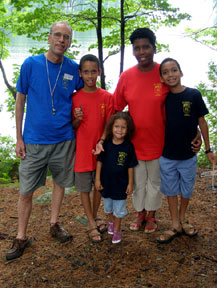 An
Update about the situation in Haiti From Paul Rudenberg
An
Update about the situation in Haiti From Paul Rudenberg
Paul was a summer staff member in 2010. Paul and his family live in Les Cayes, Haiti.
UPDATED: JAN 14, 2010
Dear Friends,
I realize that maybe I should be writing something to you all
today, but that I don't have a lot of words. I know that many many
Haitians have chosen on this day to attend some sort of religious
ceremony, or to spend some time in prayer. Last night I visited the
house where Nancy, (whom I had found in the U Miami Florida soon
after the quake with a mark on her leg for amputation) was staying:
her bed is empty there as her leg is almost fully healed after two
surgeries and has returned home. Soon she will resume her work.
Today I am traveling to Anse Rouge for a Cholera training with a
nurse named Ella. I repeatedly asked if she wouldn't prefer to stay
home with her young child instead - Ella's husband died in Port au
Prince one year ago. No - she prefers to be in the field working,
helping others to save lives. I also called Ti Louis today in the
"Radio Commerce" temporary site where I worked with others on tarps.
Now dozens of families have left with building materials to rebuild
their homes by the Red Cross, while many others have been given
transitional houses built on the site. About half of the 5,000 or so
residents are still waiting for theirs. So things are improving
there, yet there is much more to do.
If I start thinking back on January 2010, even though I was
fortunate not to lose any close friends or family that I know of,
the tears begin to flow. I can't afford to stop for that right
now, and I think this is true for the vast majority of Haitians that
I know. I have realized that Haitians have amazing survival
skills. One of them appears to me to be to not stop and reflect too
much on the past, and what has happened to them and why. I guess
this, though it seems to have its drawbacks, has helped them get to
this day and through the past year. Most are moving forward,
rebuilding, praying, and working with what seems to be hope.
Thanks for accompanying me on this journey over the last year, and
for your solidarity with the Haitian people.
yours,
Paul
Dec. 28, 2010
Dear Friends,
We send our warmest greetings for this season of hope: for
Hanukkah, the festival of lights and for Christmas, the arrival of
Emmanuel. For us in Haiti, will we be saying a special "good-bye" to
this heartbreaking, incomprehensible, and most challenging year
2010, remembering also that God has been present and working in each
moment of each day through people of compassion and love. In 2010 we
have seen like at no other time, the amazing resilience of the
people of Haiti.
This message is unusually short, because I have been working
for the past two weeks, and for several more to come, in a region
that does not have internet access- I am participating in a cholera
prevention and response program in the isolated and hard hit
northwest part of Haiti. I have been based in the town of Anse
Rouge, the salt-making capital of the country, where we are
expanding through the organization IOM, a community education
program, oral rehydration field posts, field distribution of
chlorine, "aquatabs" , soap, and oral serum, and a transport system
for those that need to be moved to the IV treatment centers. There
is a very motivated team of several nurses and ambulance drivers,
and local health agents there. I will try to keep good notes, and
let you know in several weeks how this has progressed. In the past
weeks, I had expected to write more in Les Cayes at Christmas, but
three young ones were extremely jealous of my time!
In the mean time, the donations to MFI are growing and we are
preparing for a shipment of urgent supplies to a location that is in
need. It is hard to say exactly when and where this shipment will
go.
Please continue to think of the rest of the Rudenberg family who
are keeping the home fires burning in Merci. Keep us all in prayer,
especially the people of Haiti, as they move on with hope to the new
year to come.
with love,
Paul
We are well here in Mercy at our little farm, though the news of severe unrest today from close by and in far corners of the country is disheartening.
A number of people have asked how they can contribute to the alleviation of the suffering of the cholera outbreak in Haiti. There are a number of organizations that are very active in this work, including Medical Teams International, Doctors without Borders, International Medical Corps, Partners in Health (usually well funded) and Samaritan's Purse. Supporting these organizations with a designated donation would be one way to go and this would allow a tax deductible receipt.
As an alternative, I am attempting to prepare one or more shipments of about one half ton of medical supplies to help isolated cholera treatment centers that become depleted of needed resources. The shipment would be flown to Cape Haitian, Port au Prince, or Les Cayes from Florida and then transported by truck, or possibly by helicopter by the UN via their logistics cluster, to the site of the treatment center. Each shipment would include cases of lactated ringers IV solution, oral rehydration salts, cots, buckets, pampers, disposable pads, hospital nighties, sheets, iv poles, adult and child catheters, disinfectant sprayer, mop bucket, and chlorox, Creole handouts, a few bedside toys,etc. I am working with more knowledgeable in cholera relief on the exact content for an emergency shipment. The organization that brings our mail to Haiti, Missionary Flights International, has placed cholera relief as their highest priority, and will ship these supplies to Haiti at the cost of 1.50 per pound. They will also do the purchasing locally to save on other shipping costs. They suggested they may be able to donate some supplies as well.
The choice of location in Haiti to send each shipment to will be made in collaboration with a contact I have at the Pan American Health Organization, and also via the emergency epidemic network which reports on sites in extreme need of supplies. The situation on the ground and the resources available varies from day to day, and so it would be a last minute decision before the shipment.
If you would like to participate in this effort, please send a check to:
Missionary Flights
3170 Airmans Drive
Fort Pierce,
FL 34946
The
contribution should be marked on the check, and perhaps in a
note, MEBSH -Rudenberg - Cholera Relief . Unfortunately MFI is
unable to provide a tax deductible reciept for this . If you
had found in-kind medical donations, please contact me about the
exact list first, and be sure that the cost of shipping to
Florida would not be excessive - most things can be purchased
there.
Please let me know by email
if you have any questions. As you may know, we are laying low at
home today and perhaps for several days due to the unrest
throughout the country. Keep us in prayer.
Yours, through our loving God,
Paul
Nov. 30, 2010
Dear Friends,
While following the epidemic advisory network on Nov 15, I read an appeal from a center in the town of Cazale that was being overwhelmed with possible cholera cases that came out of the mountains as well as from the river community itself. I had visited Cazale about 20 years ago, while working on the island of La Gonave. This semi-rural, community is in a river valley about 15 miles from the coastal town of Cabaret, once called Duvalierville, which is along the road north from Port au Prince. Cazale, once the home of the Polish allies to the Haitian revolutionaries, is a gateway to a large and isolated mountainous area. Straight across the mountains to the north, about 8 to 10 hours walk, is the Artibonite valley.
, The missionary nurse in Cazale, Lori Charles, had set up a cholera treatment center, and a medical friend in the US had put out an appeal for supplies - IV fluids and catheters, cots, sheets and diapers, dehydrated meals for workers, and medicines. While I had none of these, I felt called to respond. I felt some trepidation about the idea of going into the Cholera zone, but this wasn't lasting. I put out a request to the missionary community and other friends here in Les Cayes, and the recaussponse, within two days, was extraordinary: doxycycline and other medicines, cots, hygiene kits, soaps, hospital nighties, tarps and rope, bedding and pads of all sorts, and MRE's (meals). Some who could not provide supplies instead gave money so that the clinic could buy medicines, or pay the additional employees.
So on Thursday, Nov. 18 we packed the pickup truck high, filled the back seat to the brim with boxes, and I set off for Cazale. It was a national holiday - with some likelihood of protests regarding the cholera outbreak, but there was no waiting! The family sent me with instructions to stay healthy, a 5 gallon bottle of pure water, and a thermos of hot coffee. We all worried a little, but left those fears behind in prayer and with a sense of the necessity of this work and again trying to serve a suffering people. "yea, though I walk...."
The trip was smooth as could be - sunshine, a well packed car, and fresh coffee. (I don't usually travel alone, but didn't know who to ask to go into the epidemic zone with me, though the risks were low). Just past Port-au-Prince I drove over old charred tire wires, remnants of a protest earlier in the day. I arrived at the headquarters of "Samaritans' Purse", about an hour from Cazale, at 3 PM. There I visited with a friend who had worked previously with ECHO in Florida, Rhoda Beutler, who helps run their sustainable livelihood program, together with some AUC Les Cayes graduates. She introduced me to the medical program staff, Drs. Kara and Tom, and they contributed 6 more cots and offered other assistance if needed.
It was dusk when I arrived in the town of Cazale at the mission clinic, across from the river. Cazale was clearly not the same as the quiet mountain gateway I remembered 20 years before - there were many more cement houses, and much fewer trees. At the clinic I was directed across the river and up a hill, to where the isolated treatment center had been set up. Zach, Lori's father, met me there, and soon Lori arrived to rapidly separate out the supplies in the dwindling light - those that would go to the treatment center, and those that would go to the clinic. She needed to quickly get back to a dozen or so IV's and other critical tasks. I was surprised we could do this out in the open - with a large number of volunteers. Many left their boxes off on the road outside the center, not willing to approach closer. We walked 20 yards down through a millet field ready to harvest to the makeshift gateway of the yard of a new house, where supplies were piled. I would wait till tomorrow to go through the disinfection procedure and visit the patients.
In the evening I learned more about the mission from Zach, its founder. Besides the medical work they had a strong interest in helping severely malnourished children. Part of their recovery depends on a new product, made in Haiti, called medika mamba (medicated peanut butter). This helps them see a recovery from severe malnutrition in 5 weeks instead of 4 months. The children were downstairs from the guest house, fast asleep on their beds, about 20 or more. In the morning they filled the house with sound and grabbed me on my way out to visit the treatment center up on the hill.
Outside the gate of the isolated center in the middle of the grain field, one found a few people sitting and waiting. Some lying on mats, even one elderly man on a bed that had been carried from the mountains. However he was able to to lift himself up to enter the center. As you enter the gate, you are greeted by a spray of alcohol over your entire body, including your face. Its nice and cool, but quite startling. You are sprayed on the way out, too.
.
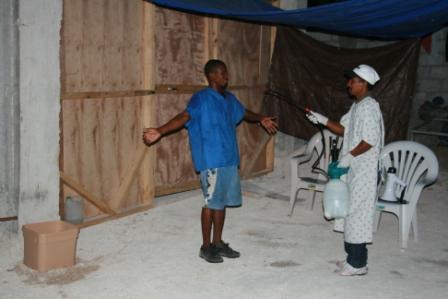
As you enter the building (a newly-built house generously donated for cholera treatment by a Haitian couple living overseas) you must wash your hands with disinfectant, don gloves, and dip your feet in a basin with a chlorox-soaked rag. Patients put on another set of clothes, their previous ones are soaked in basins of disinfectant. On the porch of the house is a row of chairs, with new patients or those receiving oral re-hydration, and usually a family member.

Each patient had a bucket under their chair, to bring out for whatever seemed necessary. Cholera causes one to produce a huge amount of fluid, to be rid by whatever fashion. This fluid must be quickly replaced or severe dehydration sets in. Drink up!
Inside the house were three rooms filled with cots in an orderly fashion, and on almost every cot was a person lying down with an IV line. Some were very awake and others in a withdrawn state.
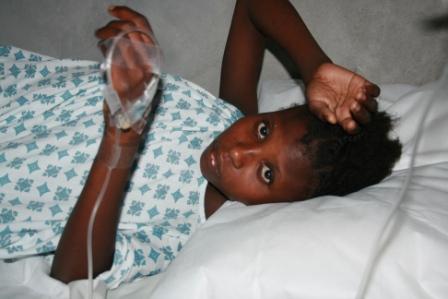
Lori and a Haitian nurse worked hard checking IV lines and other tasks. Another woman was constantly mopping and cleaning up. As a result there was no repelling smell or sense of dread about being in this place. It had an atmosphere of people working towards healing.

Many would need to stay only two or three days. Some were more mildly ill but fearing the worst, others in a state of severe dehydration that could lead to death. Now and again, however, there was one who could not be cured, but this center had a high level of success.
Brian from IOM in Les Cayes had sent tarps and rope amongst other supplies. So I spent part of my visit helping to put up a tarp in the yard. In this way the patients needed only oral rehydration could sit outside in the shade, away from the inpatient center.
After my visit to the treatment center, I returned down the hill to the guesthouse, where I was given the task to finalize the design and build some wooden IV poles. I was assisted by a staff member of the center who knew where to find all the tools. We came up with a design that could take the IV's of two patients, two medical clipboards, and a bag or two of clothing. We built them with rough lumber and then painted them white. They are supposedly working well, as can be seen below and in a previous shot.
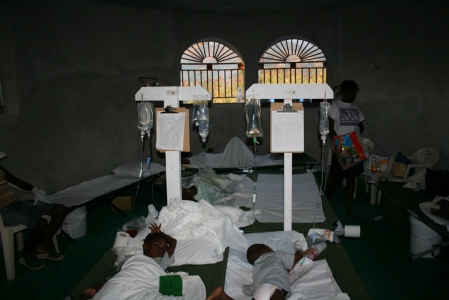
Later in the afternoon, I spent a fair amount of time back inside the treatment center with a 10 year old girl named Maudline, pictured here.
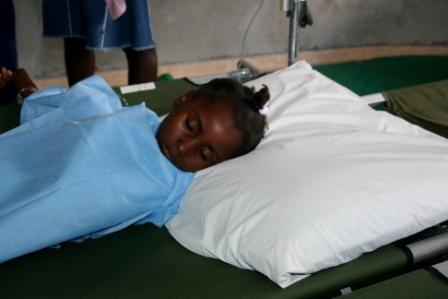
Besides having Cholera, she carried a deep sadness. She and her sister had begun the journey from her mountain village together with her mom, who also was showing symptoms. But her mother's condition was more severe and sadly, she died on the way to the treatment center. Maudline's aunt spoke of how now she had responsibility for six children and wondered how she would take this on. I prayed with this little girl and made a balloon for her from a rubber glove. I tried to cheer her a little and encouraged her to drink her oral serum so she would recover.
By the afternoon patients were appearing in the new hospital nighties instead of just wrapped in their sheets. I left the staff and patients to their hard work at hand and packed up to return to Les Cayes. I put the clothes and shoes I had worn in a separate bag,and later disinfected the car, to protect loved ones at home. The trip seemed like it might be one of many in the coming months. We don't know what lies ahead.
with love,
Paul
"Those who wait upon the Lord shall renew their strength.They shall mount upon wings as eagles."
Previous newsletter (some did not receive):
Dear Friends,
Four nights after the storm Tomas came through, our family is well and strangely enough life is back to normal. There are four trees down in the yard where sort of a sudden microburst came through our hilltop (no neighbors have any damage). The line of the downed trees goes right through our bedroom, but we were safely snoring inside at that moment. No so for tens of thousand of other families who stayed awake all night during the storm. Looking at it globally, Haiti got off lightly, much more lightly than most expected. However the Shelter Cluster has put out an initial report of 2500 homes or shelters damaged and several hundred destroyed. The worst hit area, still less severe than expected, was the western end of this southern peninsula of Haiti, and to my knowledge little information has seeped out yet about the damage to the area. . Likely damage will mainly be agricultural - banana, corn, and bean crops lost, coconut trees down, and animals lost. In addition there was a 6 foot storm surge on this peninsula so many coastal communities evacuated for one day. A UN planned overfly of this area didn't happen, but the FAO plans to survey the south this week.
There is some concern now is the effects of flooding on the cholera outbreak. When I started writing this several days ago, we appeared to still be free of cholera in the south, but this is no longer true. There are four cases in the hospital in Les Cayes from the area of Grand Riviere, about 30 miles east. At this time pretty much all of Haiti is likely to be affected. What was originally an outbreak, seemingly pretty much contained, in the areas around the Artibonite Valley where it originated, has now spread to the entire north of Haiti, with 40 suspected cases in Cite Soleil in Port au Prince, and 600 suspected cases in the north west (Gros Morne). Besides Les Cayes, there are cases reported in three major towns in the south. So we have alot of struggle and pain to look forward to before this settles into the background as an endemic disease. It is important to remember that this problem did not start in the earthquake zone, and is almost surely the result of the carelessness of the international community in Haiti. I have looked at the evidence, and to me and to many others it seems clear that an overflow during a rainstorm of a poorly protected dumping site near one of the UN bases, or of the leaking latrine tanks within the site, high up along the Artibonite River is the very likely source of the dissemination of this Asian strain of cholera that then devastated the agricultural communities and their migrant workers along the length of the river. From there one can say that the poor sanitation, lack of pure water, and poor health education around the country has led to a fairly rapid distribution.
As a family we are taking increased precautions and everyone is healthy and in great spirits. Our drinking water has been rain water from the roof, filtered through a sand and gravel filter and then chlorinated. The kids will wash their hands more often at school and we will soak all our fruits and veggies in chlorox. We will try to share these precautions with neighbors as well as I have accumulated several Creole handouts now to supplement the frequent radio spots. I will have to give up my little stops for hot sweet potatoes or coffee at the corner restaurants, for now at least.
Jocelyn Lerantus called tonight. He has a passport now, but the French consulate has not given him a visa to go to see his son, now 9 months in Martinique. Woudson is apparently well cared for in a children's home, and apparently his health is good.
The background of all this is still that of 800,000 people still under tarps or in tents. Although some of the transitional housing seems poorly anchored, or of low quality, there is clearly a desire of the international organizations to get all of these people into tin covered, wood framed temporary shelter. However the land issue is a huge one. No one really knows who owns most of the land, but the wealthy class, which received loans of large tracts of land 50 or a hundred years ago mainly for sugar cane plantations, can most easily defend their right of control "ownership". NGO's are reluctant to put an $800 to $2000 shelter onto a piece of land that a family has no paper of any kind for, though some are bending to this reality. The government will in this regard is limited, and the large landowners have more power in many cases. It is important as well to realize that some or many of the owners or holders of land in the earthquake zone now reside in the US, or may be citizens. It is a complex situation that is keeping thousands of people under tarps. I have talked to some friends in this situation - I ask them why they don't rent something, or move to their partially rebuilt house. Fear of further earthquakes is part of the reason, but also many say, "we are waiting to see what they will do with us", meaning they keep a hope that donors will help them build a permanent and safe home. This is the longshot worth keeping a tent or tarp for, though some stay only part time in this environment.There is a sense that people in the camps will get helped, and others might not. The family of Ketly, a former Heifer Project worker that was let go when they moved their office to the south, remains under a tarp in Tabarre, part of Port au Prince. She told me that if they didn't stay in the tarp site now and then the committee would take the shelter down, which could mean for them the loss of some form of aid. So it is complex limbo involving land, present fears, and future hopes.
If you look at the large scale of things - displaced people, cholera, hurricanes, one is left without much hope for this country. But I prefer to look much larger - to a loving God that has this situation and all the aid workers and the families and victims in loving care, and much smaller as well - to the individuals and see the amazing resilience, perseverance against amazing odds, and desire for a better life which for some has included some turning from old, destructive ways that is taking place in all corners. Keep each of us in prayer through the coming days.
with love,
Paul